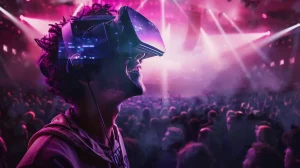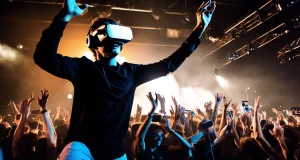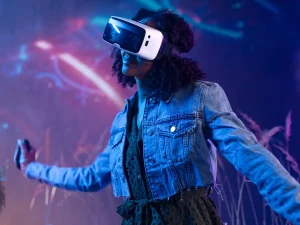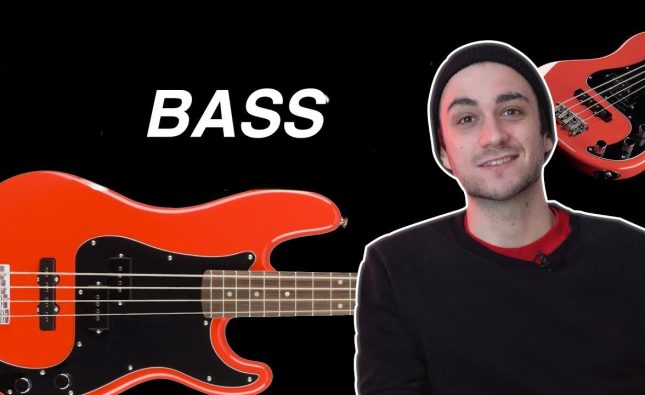
Introduction
The music world is changing fast, and technologies like Virtual Reality (VR) and Augmented Reality (AR) are playing a huge role. These technologies are changing how fans experience live music. Instead of just going to concerts, fans can now enjoy live shows in new and exciting ways. VR and AR make it possible to attend concerts from anywhere, creating a more fun and interactive experience. In this article, we’ll look at how VR and AR are transforming live music, the benefits, challenges, and what the future might hold.
What is VR and AR Technology?

Before exploring how these technologies are changing live music, let’s first understand what VR and AR are.
1. Virtual Reality (VR): VR is a technology that creates a completely digital world. When you wear a VR headset, you feel like you are inside a computer-generated environment. This allows you to experience concerts as if you were actually there, even though you might be at home.
2. Augmented Reality (AR): AR works differently. It adds digital elements to the real world. For example, through AR, you can see extra information or graphics on your phone screen while watching a concert. This makes the experience more interactive and fun.
The Role of VR in Live Music

Virtual Reality is changing the way fans experience live music by bringing the concert to them, no matter where they are. During times like the COVID-19 pandemic, when live concerts were not possible, VR became a popular way for people to still enjoy music events.
1. Virtual Concerts: With VR, fans can attend virtual concerts, feeling as though they are actually there. Using a VR headset, people can enjoy live music with 360-degree views, special effects, and even virtual meet-and-greets with the artist.
2. Personalized Experiences: VR gives fans the freedom to choose where they “sit” in the concert, whether it’s near the stage or further back. Fans can also interact with the environment, making each concert unique.
3. Amazing Visuals: VR allows artists to create imaginative worlds for their concerts. Instead of being limited by a physical stage, artists can create exciting, digital landscapes to match the music and give fans an unforgettable experience.
The Role of AR in Live Music

Unlike VR, AR mixes digital elements with the real world. For live concerts, AR enhances the performance by adding extra visuals or information for the audience.
1. Interactive Concerts: Using smartphones or AR glasses, concertgoers can view extra features during a live performance. For example, they can see lyrics or artist details appear on their phone screen while the concert is happening.
2. Fan Engagement: AR can also help fans connect with artists outside of concerts. Fans might access special content, such as backstage footage or AR-powered music videos, which deepen their connection with their favorite artists.
3. Enhanced Stage Effects: AR can be used to project stunning visuals or animations on stage, making the performance feel bigger and more interactive. These effects help create a memorable concert experience.
Benefits of VR and AR in Live Music
Both VR and AR offer many benefits that make live music more enjoyable and accessible for fans.
1. Greater Accessibility: Fans no longer need to travel to see a concert. With VR, they can attend from home. AR adds fun effects to live performances, making concerts more interactive for everyone.
2. More Fan Interaction: VR and AR allow fans to get involved in new ways. They can choose their view, explore the digital world around them, or access exclusive content, making the concert more exciting and personal.
3. New Ways to Make Money: For artists, VR and AR open new ways to make money. They can sell virtual tickets, offer special AR content, or even hold virtual concerts where fans can attend from anywhere.
How VR and AR Are Changing the Concert Experience

VR and AR are changing the way we enjoy live music. Before these technologies, attending a concert meant buying a ticket, traveling to the venue, and enjoying the performance in person. Now, VR allows fans to attend virtual concerts from their homes. They can feel like they are at the event, seeing everything in 360 degrees, as if they were in the crowd. With AR, fans can use their phones to see extra visuals or even lyrics during the concert. These technologies make concerts more fun and give fans a completely new way to experience live music.
Making Concerts More Accessible to Everyone
One of the biggest benefits of VR and AR in live music is how they make concerts accessible to people who might not have been able to attend before. For example, fans who live in different countries or who cannot afford to travel can still enjoy the experience by attending virtual concerts. AR also makes it easier for people with disabilities to enjoy the show. Special features, like subtitles or visual effects, can help those with hearing or vision impairments to feel more included. VR and AR break down many of the barriers that kept some people from enjoying live music.
Bringing Fans Closer to Their Favorite Artists
Both VR and AR allow fans to feel closer to their favorite artists in ways that were impossible before. With VR, fans can virtually stand on stage with the artist or sit in the front row, no matter where they are in the world. They can see the concert from unique angles and feel like they’re part of the performance. AR takes this a step further by adding digital elements that make the show feel more interactive. Fans can use their phones or AR glasses to unlock exclusive content, like backstage access or special messages from the artist.
Giving Artists New Ways to Perform

For artists, VR and AR offer new ways to engage with their fans and showcase their creativity. Artists can use VR to create a fully immersive concert experience, where fans can feel like they’re part of a music video or a futuristic world. With AR, musicians can project visuals on stage or on fans’ devices, making the concert feel bigger and more exciting. These technologies give artists the ability to push the boundaries of traditional performances, allowing them to tell a story in ways they never could before.
Overcoming the Challenges of VR and AR in Live Music
Despite all the benefits, there are challenges that come with using VR and AR in live music. One major challenge is the cost of the equipment. To experience VR concerts, fans need to buy a headset, which can be expensive. AR requires a smartphone or special glasses, which not everyone owns. Another challenge is the technology itself. Internet speeds need to be fast enough to support high-quality streaming, and sometimes there are glitches or delays that can affect the experience. These issues need to be fixed before VR and AR can reach their full potential.
Bringing People Together Across the World
One of the great things about VR and AR is that they bring people together, no matter where they are. Fans from all over the world can watch the same concert, enjoying it as though they were in the same room. VR allows you to “attend” concerts in places you may never have been able to visit. AR can also connect fans by letting them share experiences, like looking at the same virtual stage effects or accessing the same interactive content. This makes live music feel like it’s global, allowing people to enjoy the same show, even if they’re far apart.
New Ways for Artists to Connect with Fans

For artists, VR and AR are offering new ways to connect with their fans. They can use VR to create virtual concerts, where fans can feel like they’re on stage or in the crowd. It’s a way to make fans feel more involved and connected to the music. With AR, artists can add cool digital effects to their performances, such as light shows or virtual images, that are visible on fans’ devices. This helps artists engage with their audience in fun and creative ways, making each concert a unique experience.
Challenges of VR and AR in Live Music
While VR and AR have a lot of potential, there are some challenges that need to be worked out.
1. Expensive Technology: To enjoy VR and AR concerts, fans need special equipment, like VR headsets or AR glasses. These can be expensive, which might prevent some people from experiencing the technology.
2. Technology Problems: Although VR and AR are improving, there are still technical issues, such as slow internet connections or problems with the equipment. These can affect the quality of the concert and reduce the enjoyment of fans.
3. Artists’ Adoption: Some artists might not be ready to use VR and AR in their performances. They may not be familiar with the technology or might be concerned about the cost. It will take time for many artists to fully embrace these technologies.
The Future of Live Music with VR and AR

The future of live music looks bright, with VR and AR opening new possibilities. As these technologies improve, we can expect even more exciting changes in how music is experienced.
1. Hybrid Concerts: In the future, concerts might be hybrid events, where some fans attend in person, and others enjoy the show through VR. In-person fans might even use AR to see extra visual effects and interact with the performance.
2. Faster Streaming with 5G: 5G networks will make VR and AR concerts even better. With faster internet speeds, fans will be able to enjoy live shows in high-definition VR with fewer interruptions or delays.
3. Holographic Performances: In the future, we might even see holograms of artists performing live. This could allow musicians to perform in multiple places at once, making it possible for fans from different parts of the world to experience the same show at the same time.
Comparative Table: VR vs AR in Live Music
| Feature | Virtual Reality (VR) | Augmented Reality (AR) |
|---|---|---|
| Experience Type | Fully digital, immersive world | Digital elements added to the real world |
| Technology Required | VR headset, computer or console | Smartphone, tablet, AR glasses |
| Audience Interaction | Virtual environment interaction | Interactive elements in real-life environment |
| Use in Concerts | Virtual concerts and experiences | Interactive concert visuals, added information |
| Popularity | Growing, still in early stages | Widely used in apps and live events |
Conclusion
VR and AR are making live music better than ever before. They allow fans to experience concerts in new and exciting ways, whether through virtual concerts at home or interactive features at live shows. While there are challenges, like the cost of equipment and technical limitations, the future of live music is full of possibilities. As these technologies continue to evolve, we can expect even more creative and immersive music experiences that break the barriers of traditional concerts.










